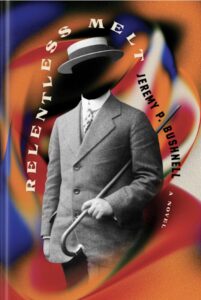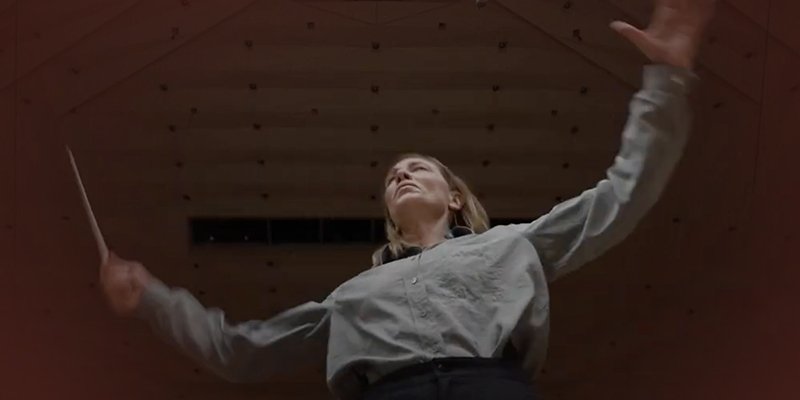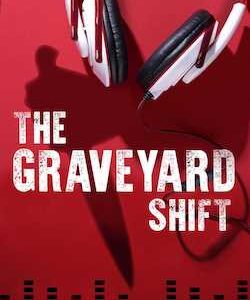I wrote much of my new novel, Relentless Melt, during the pandemic lockdowns of 2020. My partner was in another city and I spent a lot of hours alone in my apartment, grappling with the manuscript and making weird art with some remote collaborators. I’ve always used music as a backdrop while writing, but it was even more crucial during this drafting period, bringing vitality and creativity to what would otherwise have been very quiet months.
My new novel is set in 1909 Boston—but, to me, its “soundtrack” is not era-appropriate ragtime music or popular marches: rather, it is best accompanied by longform ambient tracks or noisy electronic music. The novel involves magicians who can manipulate time, so I like to think of Coil’s Time Machines as the best single pairing. This choice feels natural, partially because it’s the kind of music I wrote the book to—it helps focus the mind and block out distractions—but also because this type of music has a wonderful capacity to provoke visuals. It enlivens the imagination of readers just as readily as it enlivens the imagination of writers. So that got me thinking about what albums I’d pair with other supernatural stories.
I’d like to begin with one of the genre-defining novels:
Pairing No. 1: Bram Stoker’s Dracula paired with Jacaszek’s Treny
Rifling through my music collection to find an album that suits Stoker’s classic novel, I settled on Michał Jacaszek, an electroacoustic artist from Eastern Europe. He’s Polish, not Transylvanian, but he nevertheless perfectly nails what we might call a Transylvanian “vibe”—he masterfully evokes the craggy Carpathian landscape that we see in our mind’s eye when we read the opening chapters of Stoker’s novel. Put on any one of his dozen or so studio albums and close your eyes, and before long you too will be envisioning dark firs, grey clouds, ruined castles, tall black windows—all the elements that come together to produce what Stoker calls the “weird and solemn effect” of the Transylvanian landscape.
Weird, solemn—indisputably the Jacaszek sound. In fact, it was hard to choose just one Jacaszek album to employ as a soundtrack for Stoker’s iconic novel. (He even has an album, Music for Film, that compiles selections from his substantial body of soundtrack work, but choosing that seemed like a cheat.) In the end, I went with 2008’s Treny, which has crumbling gloom to spare but also a crepuscular blood-and-candlelight glamour that feels gloriously vampiric.
https://open.spotify.com/album/7uAEV039K5Jo52ARMALLCP
Pairing No. 2: Dan Simmons’ The Terror paired with Eric Holm’s Andøya
As the narrative of Dracula unfolds, we move from Transylvania back to the United Kingdom. From the United Kingdom, however, let’s decamp to the Arctic, following the doomed journey of Captain Sir John Franklin to discover the Northwest Passage. Simmons’ acclaimed 2007 novel covers this journey, following Franklin’s two ill-fated ships, the HMS Erebus and the HMS Terror, as they freeze in the ice near the northwest coast of King William Island. The crew gradually succumbs to disease, exposure—and monster attacks.
Andøya, the 2014 debut from UK composer Eric Holm, also documents an exploratory mission into the Arctic. (Spoiler alert: Holm survives.) Holm traveled to the Nordic island Andøya and affixed microphones to communications pylons—perhaps used for carrying espionage transmissions—and created an album of eerie, blistered electronic music from the resultant recordings. It pulsates with a bleak, rhythmic energy but the undergirding mood is threateningly solitary: a tremendous companion to Simmons’ titanic, isolated expanses.
Holm’s second album, Barotrauma, is worth a mention here as well. Holm is trained as a diver, and the source material for this album was all captured underwater: crushingly dark, haunting recordings of the sounds of the sea floor and subsea equipment. Pair it with your favorite abyssal marine thriller.
[https://open.spotify.com/album/0y6XICP8t60t9RtmTsRHO5]
Pairing No. 3: William Hope Hodgson’s “Sargasso Sea Stories” paired with Sunken’s “Steller’s Sea Cow”
If we’re going to talk about supernatural nautical stories, though, we must really give a shout to the the all-time champion of that sort of thing: William Hope Hodgson, an early 20th-century writer whose works were informed by a long stint at sea, beginning when he was 14. Hodgson’s vision of life at sea was never rosy—in fact, historian of science fiction Sam Moskowitz has written that Hodgson “hated and feared the waters with an intensity that was the passion of his life”—but it did provide generative material for his weird fiction career, much of which has marine themes and settings.
One powerful example comes in the form of a story cycle, set in the windless, uncanny region of the Atlantic known as the Sargasso Sea. Jeremy Lassen, the editor of The Boats of the “Glen Carrig” and Other Nautical Adventures: The Collected Fiction of William Hope Hodgson, Volume 1 argues that Hodgson’s “Sargasso Sea” stories are “where Hodgson first began to explore unreality, and the borderlands of human existence.”
This pairs perfectly with Eye Electric Organ, Brain Electric Nerve, a 2008 release by Sunken (a side project of New Zealand experimentalists Stefan Neville and Antony Milton). Using “organs, sonar gear, live tapeloops, vocals and an unhealthy amount of submarine reverb” they have endeavored to evoke “a terrible yet wondrous beast” which “stirs slow but sure amidst great forests of sea algae […] determined to loose its apocalyptic vision upon the earth via droning sea shanty and great humming hymn.” A more Hodgsonian vision would be hard to come by!
The portion of this available on Spotify (“Steller’s Sea Cow,” named for an extinct beast that once inhabited the Bering Sea) is a terrific nine-minute driftwork, but it’s only an excerpt of a massive thirty-minute suite (“Sounding/Salt/Seacow”) which you can snag over at Bandcamp.
[https://open.spotify.com/track/2YTvtnwvnmnespTCoP5BNb]
[https://pseudoarcana.bandcamp.com/album/eye-electric-organ-brain-electric-nerve-pa102]
Pairing No. 4 | Extremities by Kathe Koja & Paradise Rot by Jenny Hval paired with Six Songs for Invisible Gardens by Green-House
Hodgson fans in the room might also remember his story “The Voice in the Night,” a short story in which a marooned couple is horrifically transformed by a parasitic grey fungus. It’s an influential work, having been cited as an inspiration for everything from a Stephen King short story (“Grey Matter”) to Jeff Vandermeer’s ecofabulist output (most notably the Ambergris and Southern Reach books) to the psychedelic vegetable gothic phantasmagoria of DC Comics’ Swamp Thing.
A lesser-known entrant in this “fungal horror” lineage is the short story “The Neglected Garden,” which can be found in Extremities, a 1999 collection of short stories by the underrated Kathe Koja. The New York Times notes that Extremities is a collection in which “decay works as both a literal and a metaphoric protagonist,” and “The Neglected Garden” certainly rises to meet that description—it is a story in which a spurned woman impales herself on a fence, only to become, in the words of critic Elvia Wilk, “a monstrous conglomeration of human body and rotting / growing vegetal splendor.”
It’s tempting to soundtrack Extremities with the work of Norwegian artist Jenny Hval. Hval has released eight solo albums to considerable acclaim—and an early album like Viscera (2011) would work very nicely as audio accompaniment for Koja’s story. For that matter, her 2013 album Innocence is Kinky might pair interestingly with “Bondage” (a BDSM-themed work of psychological horror, also from Extremities)—heck, you could even pair her 2016 album Blood Bitch with Stoker’s Dracula. (It takes as its inspiration the vampire imagery in 1970s horror exploitation flicks.)
But I’d like, instead, to consider Hval’s lesser-known literary output here. Although not supernatural in nature, Hval’s novel Paradise Rot, a tale of psychological obsession published in an English translation by Verso in 2018, makes a wonderfully suitable companion work to Koja’s story. It shares Koja’s interest in the sensory/sensual imagery of decay; it, too, is fascinated by looking too closely at boundaries that are disintegrating into slime and slippage.
Although these literary pieces are designed to provoke uneasiness, if you look at them a certain way they can also be seen as liberatory: that the violent dissolutions they describe also serve as a form of transcendence. (In an interview, Koja has in fact said that “transformation, or more properly transcendence” is the key question in her work: how we manifest the “will to be more than we are”; what lengths we might go to in order to “accomplish that becoming.”)
So whereas my earlier soundtrack choices may have been gloomy or ominous, I elect here to close out with something more peaceful, even blissful: Six Songs for Invisible Gardens by the nonbinary Los Angeles based artist Olive Ardizoni, who records under the moniker Green-House. Six Songs owes a partial debt to 1970’s “plant utopia” albums like Mort Garson’s proto-ambient Plantasia (“warm earth music for plants and the people who love them”), but I really believe that Ardizoni’s work looks forward more than backward. Far from being retro, it points the way to a future where the breakdown of repressive culture-bound barriers might inspire us to attain new types of becoming. This is an important theme in my own novel as well, which features a gender-questioning protagonist, seeking to become more than what their culture tells them that they can rightfully be. Although Green-House’s music is gentle rather than bombastic, these six tracks are nevertheless infused with the spirit of liberation, the critical energy that pulses inside any cultural nonconformist—past, present, or future.
[https://open.spotify.com/album/5ADF8juLhrC8IerOq4G6e5]
***
RELENTLESS MELT is published by Melville House


















